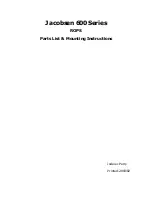
RP0575-2001
2
NACE International
________________________________________________________________________
Section 3: Determination of Need for Cathodic Protection
3.1 General
3.1.1 Experience reveals that corrosion and metal loss
is to be expected in any oil-treating vessel where any
portion of the internal steel surface is exposed to
oilfield brines because of their aggressive corrosive
nature. The need for cathodic protection is contingent
on the severity of existing or anticipated corrosion and
the extent to which it affects equipment operation.
Consistent with the latter, cathodic protection should be
installed when it will accomplish one or more of the
following:
remove or minimize unsafe conditions
caused by failure, provide economical control over
equipment failures and losses, and remove or minimize
the possibility of vessel content loss because of leaks
or vessel collapse.
3.1.2 Internal coatings may be used in conjunction
with cathodic protection to protect oil-treating vessels.
Internal coating reduces the surface area of steel to be
protected.
3.2 Corrosion Rates
3.2.1 The corrosiveness of a fluid stream is a function
of the following:
3.2.1.1 Corrosion usually becomes more severe
as the conductivity (dissolved solids content) of
water (electrolyte) increases, but low-conductivity
water can be corrosive.
3.2.1.2 Corrosion
in
produced
oilfield
brines
usually increases as the partial pressure of acid-
forming components, such as carbon dioxide
(CO
2
) or hydrogen sulfide (H
2
S), increases.
3.2.1.3 Corrosion is accelerated by even trace
amounts of oxygen.
3.2.1.4 Corrosion
usually
increases
with
increasing
temperature
unless
scaling
is
increased.
3.2.1.5 Corrosion
usually
increases
with
increasing flow velocity and turbulence.
________________________________________________________________________
Section 4: Design and Selection of Cathodic Protection System
4.1 Basic Design Criteria
4.1.1 The design of a vessel’s cathodic protection
system depends on the internal configuration of the
vessel. Selection of the appropriate system depends
on factors such as initial cost, maintenance, type and
condition of coatings (if any), power availability and
cost, and system life.
4.1.2 Vertical cylindrical vessels containing no baffles,
compartments, firetubes, etc., are usually protected
with anodes or strings of anodes suspended from the
deck (roof) of the vessel. This design method offers
two advantages over other designs: (1) better current
distribution because anodes are parallel to the vessel
walls, and (2) deteriorated or depleted anodes can be
replaced without lowering the water level or draining
the vessel.
4.1.3 Compartmented vessels or those containing
baffles, firetubes, spreaders, etc., should have at least
one anode installed in each compartment exposed to
the corrosive fluid.
If a vessel is not designed to
accommodate a cathodic protection system that will
provide effective protection throughout, it may be
necessary to make modifications or redesign the
vessel interior to provide access to areas needing
cathodic protection by installing fittings in the vessel for
inserting anodes through the walls.
An example of
such modification is positioning of a spreader in a
heater treater below the firetubes so there is sufficient
clearance to install an anode between the firetube and
spreader.
4.1.4 Correct location and position of anodes in
vessels are essential for proper current distribution.
Cathodic protection anodes should be placed such that
their protective current can be distributed to all surfaces
exposed to the corrosive electrolyte.
Each anode
should be located as near to the center of the
compartment or center of the electrolyte as practical.
4.1.5 Factors determining the number, weight, and
shape of anodes required for cathodic protection of
vessels are:
(a) area of bare water-immersed steel to be protected;
(b) current density required;
(c) anticipated current output of the anodes;
(d) vessel configuration; and
(e) desired life of the cathodic protection system.
Summary of Contents for CP 1
Page 1: ...CP 1 Cathodic Protection Tester Course Manual February 2005 NACE International 2000 ...
Page 265: ......
Page 266: ......
Page 267: ......
Page 268: ......
Page 301: ...RP0169 2002 32 NACE International ISBN 1 57590 035 1 ...
Page 535: ...TM0101 2001 24 NACE International ISBN 1 57590 137 4 ...
















































